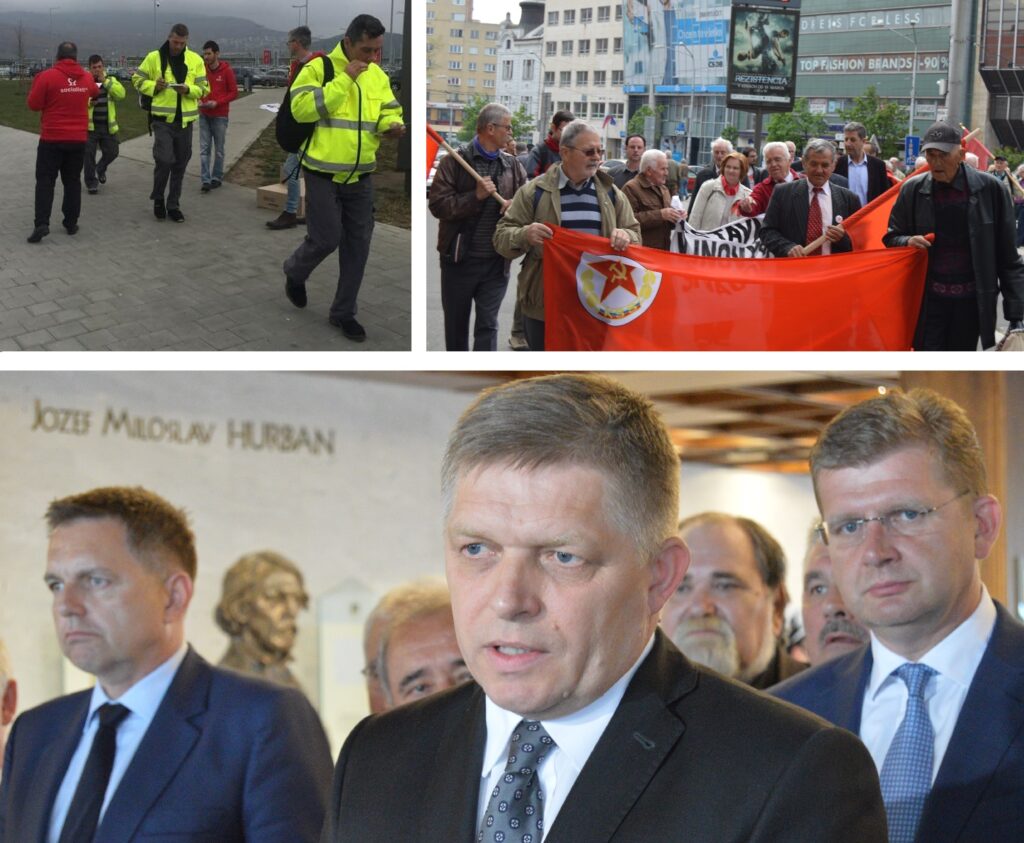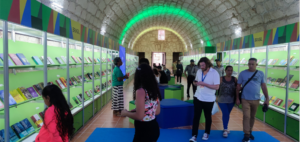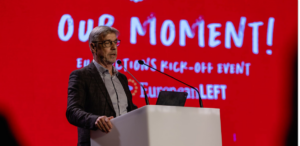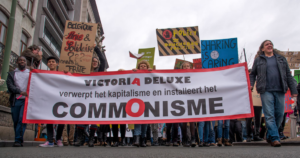The parliamentary elections in March 2020 have redrawn the political map of Slovakia. It will undoubtedly have an impact on the left spectrum as well. What is the current state of the Slovak left and what are the challenges?
Czech translation of this article is available at the website of !Argument
Shortly after the elections, the regrouping of forces, which the Slovak left has been waiting for years, began in the left space. It is no exaggeration to say that the development of the coming months will affect the shape of the left in Slovakia for at least the next decade.
A Short Excursion Into The Past
To understand the situation of the Slovak left, it is necessary to return briefly to 2012: In the March early elections, the Smer – Social Democracy party outclassed all rivals and gain of 44.4% and 83 members in the 150-member parliament allowed it to form a one-color government. For the first time since 1989, a single party has been given the opportunity to govern by itself, and thus gained room for fundamental political and economic reform.
The expectations of a significant shift of the country to the left, which could subsequently be a source of inspiration for the left in the rest of Europe, have not been fulfilled. Quite the opposite.
Topics such as the progressive tax, the development of cooperatives, unconditional basic income and the reduction of working hours remained only in the level of utopias discussed in intellectual circles. The government made rather minor amendments to the Labor Code and placed great emphasis on reducing the unemployment rate. True, the reduction in unemployment often took the form of a game of numbers, when from the point of view of the labor office it was more important to exclude a job seeker from the register of labor offices than to help them find a job in the open labor market.
Instead of massively supporting the development of the state sector of the economy, the Fico government limited itself to maintaining Bratislava Airport and gaining state-owned gas company and hydroelectric power.
The continuous increase in armaments expenditure (in 2013: 0.98% of GDP, in 2020: 1.86% of GDP, with a plan for 2% of GDP in 2020) dates back to the Social Democracy government in 2012-2016, which launched by purchasing American Spartan aircraft or Black Hawk helicopters.
Despite a unique opportunity, Robert Fico’s social democratic government not only did not dare to introduce systemic changes, but in some respects completed what the neoliberal government of Iveta Radičová (2010-2012) had not achieved before. For example, raising the retirement age.
The Social Democrats continued in an even softer tone in the next election period (2016-2020), when they already had to rely on coalition partners – the conservative right-wing Slovak National Party and the liberal right-wing Hungarian party Most-Híd.
Earthquake at the Social Democrats
Despite the fact that Smer’s policy was more social than left, the party was a power moloch that, despite losing 16% in the 2016 election, still dominated the political scene as well as the left-wing spectrum. The party was firmly straddled from the center of the political spectrum to its far positions, and in this respect it was able to bind a large part of the conservative-nationalist elements.
It was extremely difficult for any left-wing force – whether social-democratic or anti-capitalist – to assert itself.
The definitive loss of positions was triggered by the murder of journalist Ján Kuciak and the anti-government protests it provoked. From this point on, we can define the party’s policy as slowing down. Although Smer’s election campaign was conducted in a spirit of unity led by the Fico (party chairman) – Pellegrini (prime minister) tandem, information about disagreements leaked to the public. Not only political, but also personal. Therefore, the splitting of the Smer was only a matter of time…
June brought the division of social democracy into two entities. 11 deputies out of 38, led by Pellegrini, left the party and announced the formation of the Hlas – Social Democracy party.
It can be assumed that both parties will have a different style of politics in an effort to appeal to current and former Smer voters.
Peter Pellegrini will probably stay as close to the political center as possible and his oscillation to the left will be only very slight. Its target group will be an electorate expecting compromises and agreements.
Robert Fico, on the other hand, will continue to use conflict and sharp confrontation in politics. His statements on building a "rustic social democracy" suggest that his goal will be to keep a conservative voter who is sensitive to social issues.
In both cases, however, rather than the development of the left, we can speak of a regrouping of the forces of the oligarchy.
The Radical Left – Hovering On The Edge Of The Political Spectrum
If we critically evaluate the development of social democracy, we must remain equally critical in the development of parties with a communist or socialist orientation. For many years, these entities have not been able to succeed not only at the national level, but have not achieved significant success at the regional level either. Their current position is marginal.
The Communist Party of Slovakia (KSS) – despite operating on the Slovak political scene since 1992, it has so far failed to formulate a comprehensive vision that would engage the public. Not even when it was represented in parliament (2002-2006) or during the financial crisis and its effects (2008-2010). In the past decade, its main agenda has been remembrance nostalgia for the period before 1989, or reverential acts related to the events of the Second World War. The party leadership and regional structures were able to activate more significantly only during the election campaigns, but in the last elections the KSS was unable to pay a pre-election deposit (16 000 euros) and did not participate in parliamentary elections for the first time since its formation.
Moreover, in the recent period, the party’s inclination to significantly conservative positions has been evident. The latest political faux pas of the Slovak communists is, for example, participation in an anti-government demonstration of ultra-conservative groups, where the chairman of the KSS stood and spoke together with members of the far-right ĽSNS (People’s Party Our Slovakia).
Today, the current KSS offers memories instead of a vision. The overwhelming part of its ever-decreasing number of supporters is made up of conservatively oriented seniors, who were impressed in the system before 1989 by an authoritarian form of government with strong competencies of power structures limiting individual freedoms, rather than the search for an alternative to capitalism.
During the existence of the KSS, several derivatives arose from it, which were founded by members or officials dissatisfied with the internal conditions or policy of the party. However, these subjects have not been able to break through significantly in practice. The Úsvit party (founded by KSS ex-deputy Ivan Hopta) focuses exclusively on activities in a single district of Slovakia, and Vzdor – the labor party (founded by part of the KSS youth) has been exhausted after a few years. In some areas, however, the above-mentioned entities are still active, which can be assessed positively.
The initiative of left-wing activist Eduard Chmelár, who announced the establishment of the Socialisti.sk movement last summer, raised some hope before the last elections. True, even this project did not succeed in the last elections (got only 0.55%), despite the fact that its ambition was to start a discussion in Slovakia on fundamental left-wing topics.
To maintain objectivity, we state that since June 2020, the Socialisti.sk movement has been led by the author of this text. After a failed election, Eduard Chmelár resigned as chairman and was elected honorary chairman in June.
Since then, Socialisti.sk has focused on building a circle of members, supporters and activists or networking the professional capacities of the left. In addition to big politics, we have also started to pay increased attention to local and regional issues. At this point, we will refrain from assessing the extent to which the set goals are being met. If we do not want to slip into superficial self-praise, we must admit that the quarter of a year is too short to achieve tangible results and it is true that the Socialisti.sk movement is on the edge of the political spectrum without a major impact on public opinion.
What Does The (Radical) Left Need?
Above, we mapped in detail the unhappy state of the Slovak left, paying the same attention to both the systemic and the radical / anti-capitalist left.
At this point, however, we disengage from the systemic left and try to formulate what could improve the position of the radical / anti-capitalist left. There are many things that the radical left in Slovakia is missing. Finance, a broad membership, representation in parliament… However, the radical left has been struggling with these problems for a long time and in many countries.
I would divide the specifics that the radical left in Slovakia needs into three areas:
- Development of professional capacities
- Own communication channels
- Activism
Let’s change it into small ones:
1. In our opinion, the absence of a background for the growth of professional capacities and support for the non-party left is a fundamental problem. Thus, there is no single think-tank in Slovakia that brings together experienced left-wing experts and helps the professional growth of young left-wing economists, sociologists, security analysts, ecologists, etc. A think-tank that would work on studies or analyzes that serve as the basis for long-term programs of political entities. Left-wing experts are, in most cases, individuals scattered across departments or research institutes, moreover, without affecting the programs of political parties.
The atomization of the professional community of the left is subsequently reflected in the fact that the value excesses of politicians who at least formally support the left, justified by "pragmatism" or "specificity of Slovakia", remains without criticism from the left.
Therefore, in the current period, the left in Slovakia is not even the bearer of its own attitudes to current topics and problems and not their initiators at all. Rather, the left in Slovakia is expected to merely lean to one side or the other in a liberal-conservative discourse, thus depriving itself of the opportunity to win over the public.
I am convinced that if the radical left is to have a chance to reach a wide range of the population, it can only succeed with a professional program that offers society a vision for a longer period of time. And we can only formulate such a program with the help of experts. In this respect, therefore, we have a clear task ahead of us: to establish a left-wing think-tank, or at least to start networking experts across the left spectrum.
2. Another problem is insufficient media space. Non-mainstream media projects can appear as a starting point in this regard. The crisis of confidence is also affecting the media market, and the mainstream media are clearly losing public confidence. This is a chance for alternative media. Experience shows that some of them can compete with the mainstream.
A significant part of non-mainstream media in Slovakia is conservatively oriented. Not only have these projects been able to compensate for the lack of conservative narrative in the mainstream, but they have also helped to create considerable scope for conservative entities and their politicians, and in some cases have helped them to assert themselves. Therefore, I am convinced that the public would welcome the expansion of the range of opinion in the media by a left-wing view.
3. The radical left should disengage from the mantra that politics can only be started once parliamentary seats have been won. Many problems can also be solved at local or regional level. And not only on the platform of a political party, but also in the form of activism based on a non-profit organization or civic initiative. Honest activity in the field, among people (and not only during election campaigns) can also partially compensate for the absence of media space.
The disintegration of the power moloch, which for many years was covered by the brand "social democracy", gave the left part of the political scene the opportunity to breathe. However, it should be borne in mind that this moment of regrouping sponsors will not last forever. That is why we must not waste it. In Slovakia, the time has come for the radical left to have a medium, a think-tank or a network of non-profits.
However, these projects should work with the knowledge that they are not in competition with each other, but are part of something bigger, and that only through mutual cooperation they can significantly intervene in political events.
If at least part of the above-mentioned goals are achieved, the radical left has a good chance of a restart. Otherwise, I fear that it will get stuck on the edge of the political spectrum for the next decade and that the dominant element of the left spectrum will be one of the oligarchy’s projects with the attribute of "social democracy".



